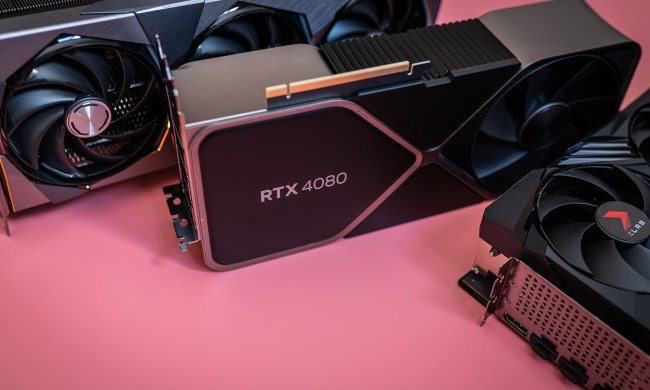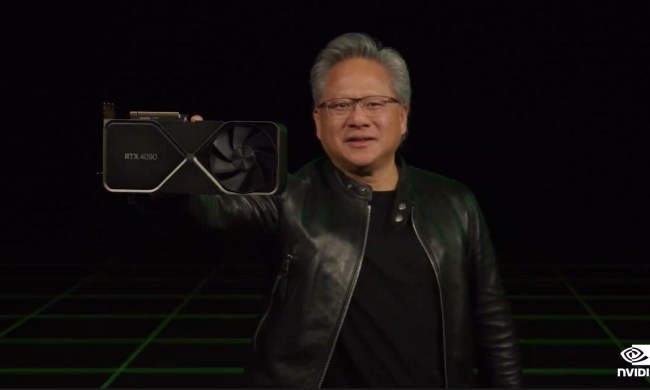At the top of Nvidia’s current generation of GPUs sit two beastly graphics cards, the RTX 4090 and the RTX 4080. While the RTX 4090 is a monstrous GPU, the 16GB version of the RTX 4080 still has a lot to offer. On the other hand, both cards are vastly different in terms of price, performance, and specifications.
Below, we’ll explore how the RTX 4080 stacks up against Nvidia’s flagship and whether it’s a worthwhile pick instead of the RTX 4090.
Pricing and availability
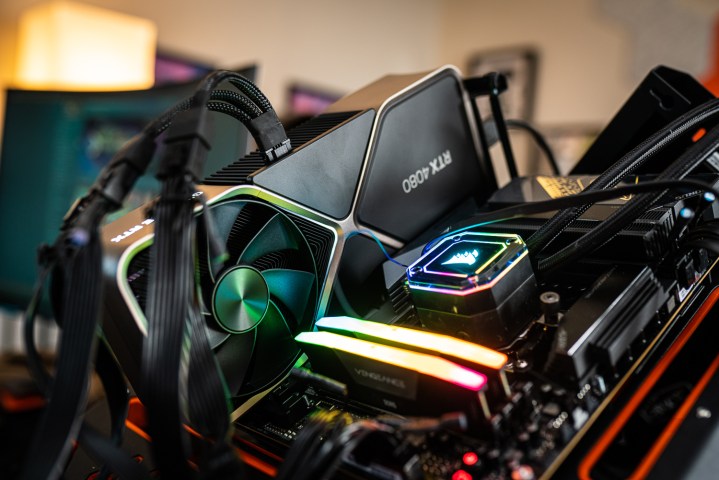
Nvidia is not known for making its GPUs cheap, so it should come as no surprise that both the RTX 4090 and the RTX 4080 are quite expensive. The RTX 4080 actually had a younger sibling, the RTX 4080 12GB, before Nvidia decided to “unlaunch” it — perhaps in part due to the fact that it was priced so badly that many Nvidia enthusiasts were unhappy with the cost-to-performance ratio offered by the card.
Fortunately, the RTX 4080 16GB — which is the only RTX 4080 we know of now — fares better, but it’s still a rather pricey card.
The RTX 4090 came first, launching on October 12, 2022, with a $1,599 price tag. Of course, Nvidia’s add-in board (AIB) partners made their own versions of the GPU, pushing up the specs and the performance at a premium. Some of these cards are now available for sale for as much as , although there are cheaper cards to be found. The GPU sold out quickly and its availability is now rather spotty.
As for the RTX 4080, Nvidia set its release date as November 16 with a starting price of $1,199. You can expect Nvidia’s AIBs to price the card higher in some cases, so you may need to budget for an extra $200 to $300 on top of that price by default — there’s no telling how high the prices can go once the card is sold out, though.
Specs

Despite only being 25% cheaper than the RTX 4090, the RTX 4080 takes a rather big cut in terms of specifications, sporting 41% fewer CUDA cores. This is later reflected in its performance. On the other hand, the RTX 4090 is such a powerful GPU that many games don’t even need that much power just yet, so this disparity doesn’t inherently make the RTX 4080 a bad GPU at all.
Let’s see how the two cards compare on paper.
| Nvidia RTX 4090 | Nvidia RTX 4080 | |
| CUDA cores | 16,384 | 9,728 |
| Ray tracing cores | 144 | 76 |
| Tensor cores | 576 | 304 |
| Base clock speed | 2,235MHz | 2,205MHz |
| Maximum clock speed | 2,520MHz | 2,505MHz |
| Memory size | 24GB GDDR6X | 16GB GDDR6X |
| Memory speed | 21Gbps | 21Gbps |
| Bus width | 384-bit | 256-bit |
| Total Board Power (TBP) | 450W | 320W |
Performance
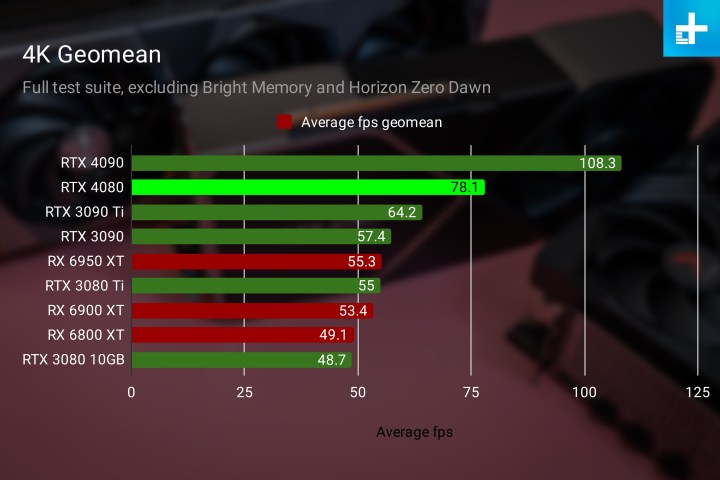
We’ve tested both the RTX 4090 and the RTX 4080 extensively ahead of their respective launch dates. Having put the cards through the wringer, we’ve got plenty of benchmark results to help us determine their performance.
It should come as no surprise that the RTX 4090 sweeps the floor with every other top-notch GPU on the market right now, including the RTX 4080. The question is just how badly it destroys the RTX 4080 and not whether it does or doesn’t win, because that’s a given.
Despite not being as good as the RTX 4090, the RTX 4080 is still very much a graphics card made to run games on 4K, and that shows in our testing. It managed to run AAA titles while maintaining solid frames per second (fps). On average, across our test suite, the RTX 4090 scores 108.3 fps in 4K gaming ,while the 4080 hits 78.1. The 4080 beats every other graphics card currently out there, but it’s still around 29% slower than the flagship card.
Even in games as demanding as Cyberpunk 2077, the RTX 4080 did a good job, just barely missing the 60 fps mark at 4K on max settings. Take the settings down a notch and you’ll be playing at a smooth 4K. The RTX 4080 manages 78.6 fps on max settings, though, doing what seemed to be impossible around the time of Cyberpunk’s launch.
The RTX 4080 outpaces its older last-gen sibling, the RTX 3080 Ti, significantly. The card is 42% faster than the 3080 Ti and even 22% faster than the 3090 Ti. Whether it’s better value will depend on the pricing around the time of launch as the prices may be inflated at first.
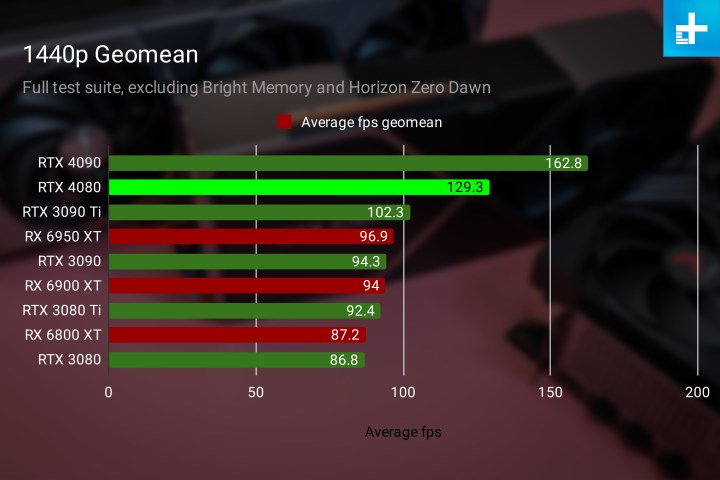
Getting an RTX 4090 for 1440p gaming seems like a waste of money, but the RTX 4080 is a more reasonable choice despite its 4K gaming capabilities. Across our full gaming test suite, excluding Bright Memory and Horizon Zero Dawn, the RTX 4090 maintained 162.8 fps on average while the RTX 4080 hit 129.3. Again, both cards outperformed every single GPU from the previous generation by a mile.
Compared to the RTX 4090, the 4080 was around 21% slower in 1440p. We’re still seeing good gains over the previous generation, though. Compared to the RTX 3080 Ti, the RTX 4080 won by a massive 40%, and this is not even the Ti model. It also beat the previous flagship RTX 3090 Ti by 26%.
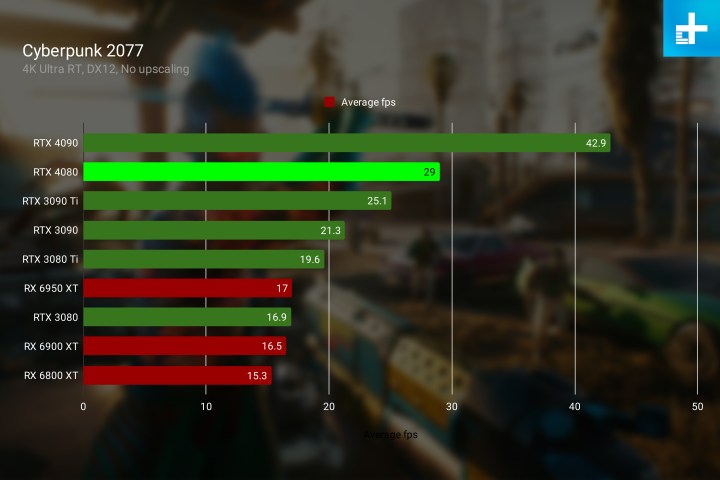
Nvidia is the ray tracing king, leaving AMD in the dust in most benchmarks. However, the RTX 4080 doesn’t bring a significant boost in ray tracing (RT) in every benchmark we’ve run.
Running Cyberpunk 2077 at 4K with ray tracing on is a dangerous move, and while the RTX 4090 somewhat manages to pull it off with 42.9 fps on average, the RTX 4080 trails behind with just 29 fps. In Metro Exodus Enhanced Edition, the frame rate averages are much better, but also still much more in favor of the RTX 4090: the flagship scores 108.5 while the RTX 4080 hits 78.4.
The RTX 4080 still shows generational improvements over the previous gen. It’s around 15% ahead of the RTX 3090 Ti in Cyberpunk 2077. On the other hand, the RTX 4090 is just insanely good at ray tracing in comparison, being nearly 48% faster than the RTX 4080.
Lastly, both the RTX 4090 and the 4080 open the door to a whole new world of Nvidia’s DLSS, granting access to its third iteration (DLSS 3). The tech is capable of generating new frames instead of just pixels. It’s not without flaws, but it can certainly make a difference in some games, and the previous generations don’t support it, so that gives the RTX 40-series an advantage.
The RTX 4080 is great, but …
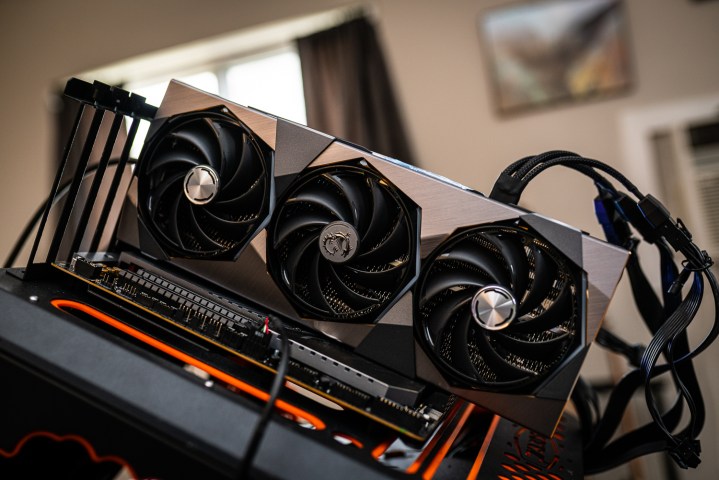
If you’re still left wondering whether your new rig needs an RTX 4090 or an RTX 4080, you’re probably not alone. This generation of graphics cards makes this type of choice more difficult than it has ever been.
In the previous gen, the pricing and the performance usually pushed PC builders one way or the other. This time around, Nvidia priced the RTX 4080 in such a way that this choice is no longer so clear-cut. It also depends on when you’re planning to shop.
Right now, the RTX 4090 is insanely overpriced, but if you can find it at the recommended list price or close to it, it offers a huge step up in performance over the RTX 4080. From the get-go, the RTX 4080 is going to be cheaper, but prices may go up if the card sells out quickly. To put it simply, the first few months after a graphics card launches tend to be turbulent and the prices will take a while to settle — this applies to both GPUs.
Assuming you’re able to find an RTX 4090 and an RTX 4080 at the list price (in which case, please share your sources), you’re going to look at a different sort of dilemma. It’s a frequent problem for those who are building a new PC — “if you spend a little extra, you can get this much more performance.” In the case of the RTX 4080, it’s only around 25% cheaper but also around 30% slower.
Strange as it may be, the $1,600 RTX 4090 is technically better value, but most users don’t even need that kind of performance. The RTX 4080 is a fantastic card capable of running AAA games at 4K, and it will save you money compared to the RTX 4090. It all comes down to what you need and how much you’re willing to spend.
If you’re in no hurry to shop, wait out the initial storm and get the RTX 4080 to save money or the RTX 4090 for better value — again, only if it’s near MSRP. It’s never going to be good value if you pay $2,500 for it.


